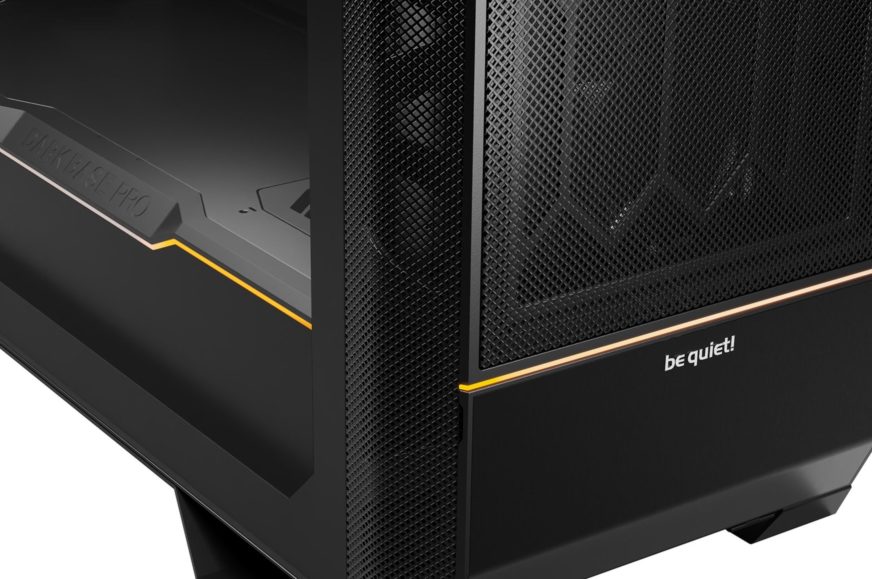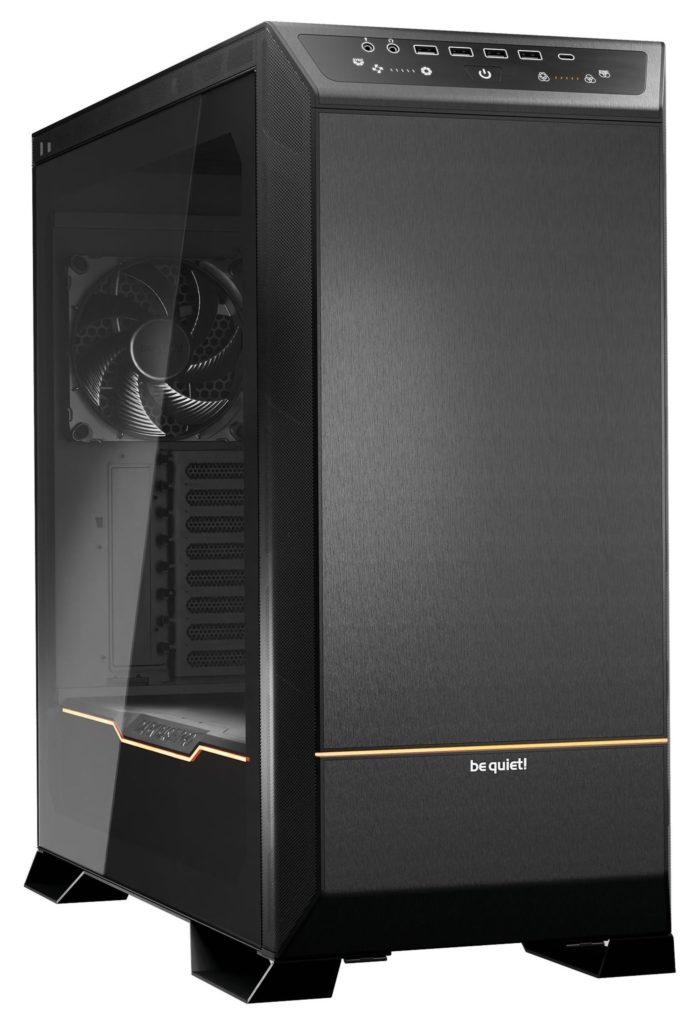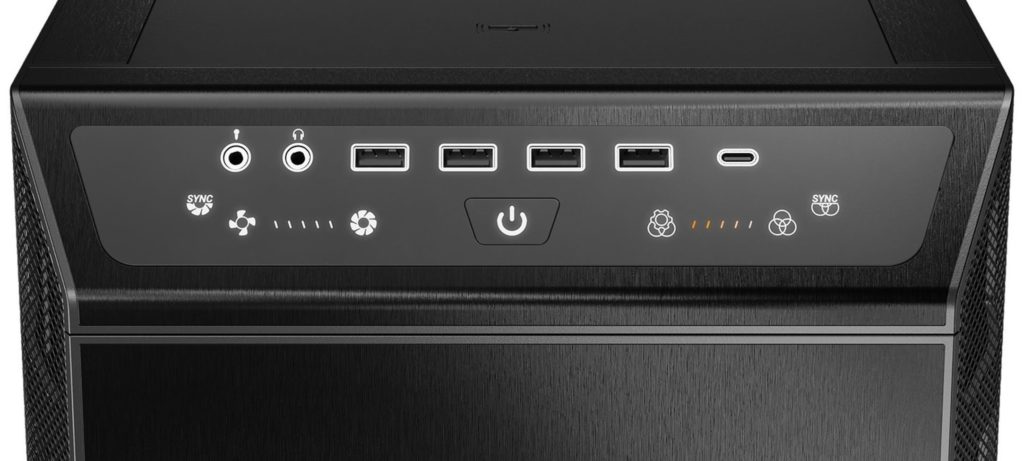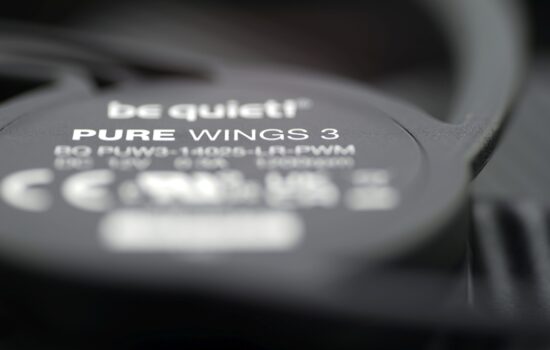BeQuiet! Dark Base Pro 901
With the Dark Base Pro 901, BeQuiet! has raised the bar not only within their cases, but perhaps overall. For the first time ever, the Silent Wings 4 appear in system fan positions. In addition to the robust build, this full tower also has a touch panel for fan and lighting management. Compared to its predecessor, there is also a significantly changed side panel. The door, while significantly changed, has remained on the case.
The Dark Base Pro 901, a new top model weighing as much as 16.3 kg, has been added to the high-end computer case product line. This case is even bigger than its predecessor (Dark Base Pro 900), especially in terms of depth – i.e. front-to-back dimension. On this axis, BeQuiet! measured up to 604 mm. In height (including the feet) it is then 569 mm and in width 275 mm.
With such dimensions, it is natural that there are virtually no limitations for components. Be it the length of the graphics card, the height of the tower cooler on the CPU or the format of the motherboard. Support also includes the XL-ATX format, which features a combination of above-standard width (up to 264 mm) with above-standard height (up to 345 mm). There are three different positions for a larger, 360-millimeter liquid cooler radiator – the front, side and ceiling of the case. There, below the ceiling, a 420 mm radiator is also supported.
For those who don’t like the traditional layout scheme where you access the motherboard through the left side panel with the motherboard I/O panel on top, it is possible to rotate everything here. So that the components will be on the opposite side (i.e. you’ll be accessing them from the right) with the motherboard “upside down”. But you could already swap the tray like this with the older Dark Base Pro 900.
The front panel design philosophy is completely new. Its design no longer includes a large door to the 5.25″ slots and to the dust filter, but is solid. Optionally, you have the choice between perforated and full panel, the same in the top position. If you don’t have fans in it and also want to seal the top from dust ingress, it can be fitted with a sealed panel.
And although BeQuiet! seems to have dropped the option of installing an optical drive for now, it hasn’t. It’s easy to overlook the 5.25″, not least because it’s in an atypical location – behind the door at the bottom of the front panel. These are horizontally separated by a strip of ARGB LEDs. This is followed by a light guide line stretching along the interior of the case along the edge of the secondary chamber for installing the power supply and storage drives.
Colors and lighting effects can also be controlled from the control panel, which features five USB ports (4× 3.2 gen.1 type A and 1× 3.2 gen.2 type C, the full lineup of faster standards that can be connected from motherboards) in addition to a multi-stage controller for changing fan speeds. BeQuiet! no longer uses a mechanical switch for this purpose, but a capacitance plate. Of course, everyone may have a different opinion on whether this is an improvement or a downgrade. Visually it looks impressive and how reliable (or unreliable) the response to pressing will be, will only be known from tests.
The strong point of the Dark Base Pro 901 is the three pre-installed Silent Wings 4 fans in 140 mm format, no need to argue about that. “Pro” variants (Silent Wings Pro 4) with the same rotor achieve top-notch efficiency and the fact that “basic” Silent Wings 4 do not have tighter corners (than the SWP4) does not negatively affect the cooling performance in this application (as it happens on radiators). On paper, the case looks really good and we expect it to deliver top efficiency, i.e. high airflow per unit of noise.
But the suggested retail price will also be high, BeQuiet! set it at 320 EUR. Dostupnosť Dark Base Pro 901 is supposed to be in stock on June 27, 2023.
English translation and edit by Jozef Dudáš
- Contents
- BeQuiet! Dark Base Pro 901















The mounting of front intake fans is very bad.. The intake part of front fans contacts completely with the mounting structure of the case. This can not only raise overall noise level significantly, but also generate unpleasant periodic sound for some fans(NF-A12X25 is the typical example).
Yeah. I’m waiting for some of the case manufacturers to finally come up with a tunnel system that works on the principles of the Noctua NA-IS1. 🙂
Yeap, although this is very simple solution, it seems that few manufacturers are clear about this issue.
By the way, I have a question about case cooling.
How do you think about dealing PC cooling in terms of overall air pressure inside a case? We can find some articles claiming the relation between total pressure and PC cooling. They say this as below:
1. Negative pressure: Good at cooling VGA, More dust
2. Positive pressure: Good at cooling CPU, Bad at cooling VGA, Less dust
But I’m a bit suspicious about these relations. I think case fans can make ‘local’ pressure difference near them, but not entire pressure offset. Usual case fans can make up to 2mmH2O ≒ 1.94*10^(-4)atm pressure difference which is too small value to make measurable entire pressure difference inside a case in my opinion.
I wonder what your opinion is!
I read a lot on SFFPCs (small form factor pcs) where there are a lot of different airflow designs, so I think I can offer some input.
Overall case pressure is important if you have vents not occupied by fans. If the overall pressure is negative, all non-occupied vents become air intake, vice versa. You can actually test it by putting tissue paper near the vents.
In the SFF world you cannot bruteforce cooling by blasting a ton of air through the case. The most efficient way to ensure proper cooling which minimal amount of fans is to prevent air recirculation, where overall case pressure can play a part in.
In cases where the CPU cooler and GPU are close to the side panels (say in sandwich cases like the Dan A4-H2O), focusing on exhaust fans is ideal, which help lower pressure inside the case, thus help draw air from outside the case into the heatsinks, preventing recirculation of heated air. If there are no case fans (say Dan A4 SFX and Fractal Terra), the case will be in slight positive pressure due to the CPU and GPU fans acting as intake fans, thus all vents want to become exhaust vents, including the CPU and GPU intake vents, which causes lots of recirculation and bad thermals. It can be solved, however, with ducts such as the Noctua NA-FD1 which is another way to overcome the issue of recirculation.
A good example of non-ideal airflow design is the Fractal Ridge which HWcooling have reviewed. The case uses two 14 cm fans which locally blast air at the GPU, so GPU thermals are excellent. CPU though, not so much, as the CPU intake fan is fighting against the positive pressure in the case which want to dump the air out from every vent including the CPU intake vent! In the same review you can see a phenomenon where increasing case fan speed actually causes a deterioration in CPU thermals. I strongly believe that putting the fans behind the GPU, exhausting air would be an overall better design.
Another example is again from Fractal, the Torrent Nano specifically. Unlike larger versions where there are two front case fans, the Nano only has one which sits above the GPU. Out of the box, this results in very poor GPU thermals, which is reportedly fixed by adding a fast -running exhaust fan in the back. This is yet another case of the unoccupied vents unintentionally becoming exhaust due to positive pressure.
A good example of non-conventional but very effective airflow layout is the NR200p (and similar cases like NCase M1 and Dan C4). The optimal configuration for aircooling in that case is to have bottom intake fans (which gives constant fresh air to the GPU, local positive pressure in a sense), top exhaust fans which help bring the overall pressure in the case to neutral or negative, and have the CPU tower taking in air from the back (which is effective thanks to the top exhaust fans).
In “conventional” tower cases, the same principle can be applied, mainly on the unused PCIe slot covers. If the case is at negative pressure, some air will flow through the slot covers right into the GPU fans, which in turn may increase the amount of fresh air being delivered to the GPU. In positive pressure mode the vents will be exhausting air, so the GPU is entirely dependent on the front fans to deliver air. As you can imagine, if air is flowing in through the unfiltered PCIe slot covers, dust will naturally come inside too. So to answer your question, I would say the two statements you mentioned have truth in it. Of course there are always exceptions, but they’re fine as rule of thumbs.
Just something extra, in general I don’t think the conventional airflow design is anywhere near optimal. Fan and vent placements are critical and you have to keep in mind that depending on the overall case pressure the vents may not be having airflow in the direction you wanted (which however can be reversed by clever placement of fans). Having more vents isn’t necessarily better, compared to strategically placed vents.
Hope this helps!
P.S. I have been following your posts on Quasarzone, very nice work! The newest article on the Seasonic fan is particularly excellent as you start including more obstacles in your tests. You might consider starting a website or something…
Thank you for your detailed opinion! It really helps to get summarized contents about various airflow design of SFF cases.
But actually, my question is more like: “Does the entire pressure difference of PC case exist with meaningful quantity?”
The above contents about entire air pressure starts from the hypothesis that claims the existance of significant amount of Atmosphere pressure – ∑[Air pressure inside a case].
If the difference is big enough, the theory about pressure can become a hypothesis that explains better the real-world phenomenon and make useful expectation about PC cooling. It is important to verify the hypothesis about something before using it, enabling us to form better model of reality!
So I’m now devising how to measure pressure inside a case easily and accurately. (and also cheaply 🙂) It should be measured for many positions as possible to obtain more approximate average pressure, making a headache in the progress of plan.
+ It is surprise that you have read my articles on Quasarzone. Much appreciated for your praise!
Actually I already made the results for much more obstacles (9 different scenarios in total) a year ago but didn’t open them to the public because of wrong methodology of noise-normalization. It’s a little disappointing that I have only recently been able to reveal the small proper results.
Aside from measuring pressure differential, I think it would be beneficial to have some way of visualizing airflow inside a case, which I think will compliment well with pressure data. I have seen smoke generators being used for this purpose but I am not sure if it’s safe and if it provides and accurate picture of what’s happening inside the case.
Wish you luck, I really appreciate you for constantly working on improving your methodologies.
Maybe measuring horizontal/vertical air speed with small anemometer for each positions can quantify airflow inside a case. This is because the velocity vector of a position can be obtained if the velocity for the two vertical components is known. I also know how to drive fluid simulation(Ansys Fluent or Discovery) for simple situations so that this can help cross-verification of measured results.
Thank you!
Did you come across our old article in which we tested different configurations of fans with induced positive pressure, negative pressure and balanced airflow? Today I would probably do it a bit differently, in more detail and create more model situations (different case designs with different fans) and I’ve been planning to do something like that for years, but it’s very hard to find the time to do it. I like the way you are thinking about this topic, but it would be a hell of a lot of work. 🙂
The post by user M contains many interesting insights.
Oh, I just read it for the first time. It is very old article, but still useful to study about this topic!
I hope that one day we will be able to obtain experimental conclusions. It’s not easy for me either to find the time to work on these kinds of long-term projects.
Maybe doing simulation can help to create basic research materials.
I think a better solution is to use dedicated brackets for different sized fans instead of compromising by supporting both 12 and 14 cm fans using the same bracket, which blocks a lot of airflow when using 14 cm fans. Or, dedicate support to only 14 cm fans and sell 12 cm fan adaptors.